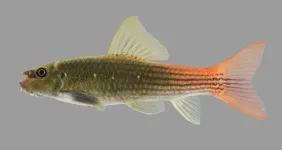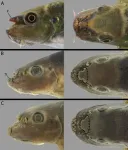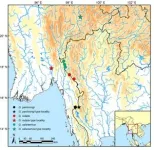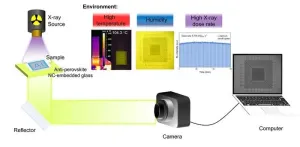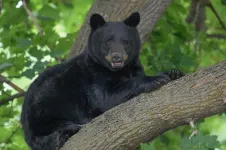(Press-News.org) With just a few clicks of a mouse, you can purchase your very own redtail garra, a type of fish that feeds on algae. Information about the fish’s biology, however, is much less easily obtained. That’s because redtail garra, although popular in the aquarium trade since the early 2000s, has until now been unknown to science.
Researchers were peripherally aware of the fish’s existence, but “discovering” a new species requires scientific description based on specimens collected in their natural environment. Redtail garras appear to be restricted to a small stretch of river straddling the border between Thailand and Myanmar. The locality is isolated and difficult to reach, so wild redtail garras have existed in relative obscurity, despite their global appeal.
Larry Page, curator of ichthyology at the Florida Museum of Natural History, has surveyed fishes in Thailand every year since 2007. He recently encountered a few redtail garras while conducting fieldwork along the Kasat River, a tributary of the Ataran River in neighboring Myanmar.
“When we first collected specimens, we thought it must be widespread in Myanmar because of its popularity in the aquarium trade. But it turns out it’s not. It’s only in the Ataran River basin,” he said.
Page and his colleagues published the new species description in the journal Zootaxa. Redtails take their place among nearly 200 additional species in the genus Garra, one of the most diverse and widely distributed fish groups anywhere on Earth. Garra can be found in streams and rivers from the farthest reaches of western Africa through the Middle East, India and southern and eastern Asia, including parts of China. Yet their ubiquity has not resulted in a corresponding amount of research on the group.
“There’s surprisingly little information on their natural history,” Page said. There are few studies that broadly assess diversity in the genus, and little is known about relationships or how various groups within Garra have diversified.
According to Page, basic information about the fishes’ biology is available, but often in the form of studies on individual species or regions. “Most of them live in fast-moving water, and they have a disclike structure formed from a modification of the lower lip, which they use as an adhesive pad to cling to rocks and maintain their position in the water column as they feed,” he said.
Garra primarily subsist on algae and the occasional arthropod, which they eat by scraping detritus off rocks with specialized mouthparts. Like other species in the genus, redtails lack stomachs and have a snout encrusted with modified and hardened scales called tubercles. Similar structures in other fish groups are temporary; they’re used to defend nests but fall off after the breeding season has ended. Redtail tubercles are permanently attached and seem to be used as weapons, based on aggressive behavior observed in aquaria.
Redtail garra can be distinguished by their unique, elongated snout, covered in even more tubercles, which they can raise or lower, ostensibly as a means of intimidating opponents during combative encounters. And, as their common name suggests, their tails are emblazoned in red like a signal fire.
Their unique color pattern and their industrious ability to clear away algae have made them a coveted component of aquarium tanks, but their late addition to the roster of scientifically described species underscores a pressing need to take stock of biodiversity in understudied regions.
Page, who is working on a book describing the fishes of the Mae Klong River basin in Thailand, said the belated description of redtail garra is part of a larger recurring pattern. “Many of the fishes in Southeast Asia are referred to by names given to species discovered in India or Indonesia because they look similar.” People know particular species exist, Page said, but they are mistaken for those from other geographic areas, and their diversity has consequently been drastically underestimated.
Page and his colleagues named the new species Garra panitvongi after the author of another book on Thailand’s fishes, Nonn Panitvong. Lauded as a biodiversity hero by the Association of Southeast Asian Nations, Panitvong is both a businessman and an avid naturalist. He’s nurtured a passion for nature since his childhood days spent translating books about animals written in English with the help of his mom. He developed a special appreciation for Thailand’s aquatic life from his dad, who took him on fishing trips.
“Over the years, I found that in many of the places we went fishing, the environments were getting worse. There were fewer fish overall, and the fish assemblage changed for the worse, with a decreasing number of native species and more invasives,” he said.
Panitvong obtained a Master of Business Administration at the University of North Carolina Wilmington so he could effectively run his family’s sugarcane farm, but when it came time for a doctorate, he opted to study environmental science. After returning to Thailand, he created the website Siamensis.org, an open platform on which nature enthusiasts could share information about Thailand’s flora and fauna and plan excursions to wilderness areas.
In 2006, Panitvong and a friend discovered one of Thailand’s redtail garra populations and helped introduce the fish to the aquarium trade. Now, more than 15 years later, he said the official naming of redtail garra — and the discovery of species like it — help bring the world into clearer focus.
“I like to imagine humanity in a big room, painted in white. As we turned around, we would have no conception of which direction we were facing,” he said. “With each new discovery, a dot is added, a point made, and we know more and more about where we stand as a species.”
END
New fish species discovered after decades of popularity in the aquarium trade
2023-07-10
ELSE PRESS RELEASES FROM THIS DATE:
Hospital understaffing and poor work conditions associated with physician and nurse burnout and intent to leave
2023-07-10
PHILADELPHIA (July 10, 2023) – A unique collaborative study on hospital clinician wellbeing by teams at 60 of the nation’s best hospitals, defined by Magnet Hospital Recognition, was published today in JAMA Health Forum. The study found that physicians and nurses, even at hospitals known to be good places to work, experienced adverse outcomes during the pandemic and want hospital management to make significant improvements in their work environments and in patient safety. The solutions to high hospital clinician burnout and turnover, they say, are not resilience training ...
Anti-inflammatory drugs did not speed COVID-19 recovery but prevented deaths
2023-07-10
Two drugs commonly used to treat inflammatory diseases such as rheumatoid arthritis and psoriasis did not shorten recovery time for patients hospitalized with severe COVID-19 but did reduce the likelihood of death when compared with standard care alone, according to a national study led by Washington University School of Medicine in St. Louis. The study was funded by the Biomedical Advanced Research and Development Authority (BARDA) of the Administration for Strategic Preparedness and Response within the U.S. Department of Health and Human Services (HHS). The study was coordinated by the National Center for Advancing Translational Sciences (NCATS) of the National Institutes of Health ...
Illuminating the future of X-ray imaging: High-resolution and ultrastable solutions with lead-free anti-perovskite nanocrystals
2023-07-10
In the realms of material inspection, medical diagnostics, astronomical discovery, and scientific research, the demand for high-resolution and ultrastable X-ray imaging methods has ignited a fervent pursuit of innovative X-ray-responsive materials. These sought-after materials must possess exceptional qualities such as high X-ray attenuation, efficient scintillation, rapid light decay, and robust durability. Among them, lead-halide-based perovskites have emerged as a compelling contender due to their remarkable luminescence efficiency, superior X-ray attenuation capabilities, and short ...
DOE announces $72 million for small business research and development grants
2023-07-10
WASHINGTON, D.C. — The U.S. Department of Energy (DOE) today announced $72 million in funding for small businesses to pursue scientific, clean energy, and climate research, development, and demonstration projects. The funding will support 296 projects across 44 states and addresses multiple topic areas, such as renewable energy, nuclear energy, cybersecurity, advanced materials and manufacturing, microelectronics, and artificial intelligence. Today’s announcement underscores the Biden-Harris Administration's deep commitment to advancing innovative climate solutions and strengthening America’s ...
Personalized oral cancer survival calculator to estimate risk of death from oral cancer or other causes
2023-07-10
About The Study: The models developed for the Surveillance, Epidemiology, and End Results Oral Cancer Survival Calculator demonstrate that survival estimates that exclude the effects of coexisting conditions can lead to underestimates or overestimates of survival.
Authors: Louise Davies, M.D., M.S., of the Department of Veterans Affairs Medical Center in White River Junction, Vermont, is the corresponding author.
To access the embargoed study: Visit our For The Media website at this link https://media.jamanetwork.com/
(doi:10.1001/jamaoto.2023.1975)
Editor’s Note: Please ...
Key points for clinicians about the SEER oral cancer survival calculator
2023-07-10
About The Article: This article describes the Surveillance, Epidemiology, and End Results Oral Cancer Survival Calculator, which is designed to provide patient-specific survival estimates based on the severity of an index cancer as well as the competing risk of death of other comorbid ailments.
Authors: Louise Davies, M.D., M.S., of the Department of Veterans Affairs Medical Center in White River Junction, Vermont, is the corresponding author.
To access the embargoed study: Visit our For The Media website at this link https://media.jamanetwork.com/
(doi:10.1001/jamaoto.2023.1977)
Editor’s Note: Please see the article for additional information, ...
Global study finds while humans sheltered in place, wildlife roamed
2023-07-10
MISSOULA – While humans sheltered in place during the COVID-19 pandemic, wild animals took the opportunity to roam spaces typically avoided by wildlife, according to a study published last month in Science. Photos quickly emerged of wild goats spotted on the city streets of Wales and coyotes touring downtown San Francisco, yet evidence explaining this phenomenon was sparse.
Dr. Mark Hebblewhite, professor of ungulate habitat ecology at the University of Montana, joined an international research team of 175, led by Dr. Marlee Tucker – an ecologist at Radboud University in the Netherlands – in analyzing ...
Curious compound: Tin selenide may hold the key for thermoelectric solutions
2023-07-10
Researchers at the FAMU-FSU College of Engineering and the National High Magnetic Field Laboratory discovered that atomic-level structural changes occur when the compound tin selenide heats up — changes that help it to conduct electricity but not heat.
The study, funded by the National Science Foundation and Department of Energy, provides information that could lead to new technologies for applications such as refrigeration or waste heat recovery from cars or nuclear power plants. The research was published by Nature Communications.
“Tin selenide is a curious compound,” ...
Massachusetts drinking water may contain unsafe levels of manganese
2023-07-10
FOR IMMEDIATE RELEASE
Contact:
Jillian McKoy, jpmckoy@bu.edu
Michael Saunders, msaunder@bu.edu
##
Massachusetts Drinking Water May Contain Unsafe Levels of Manganese
A new study measured manganese levels in the residential tap water of a Holliston, Mass. community and found that the manganese concentrations occasionally exceeded the maximum safety level recommended in state and federal guidelines.
Manganese is ...
Scientists discover 36-million-year geological cycle that drives biodiversity
2023-07-10
Movement in the Earth’s tectonic plates indirectly triggers bursts of biodiversity in 36‑million-year cycles by forcing sea levels to rise and fall, new research has shown.
Researchers including geoscientists at the University of Sydney believe these geologically driven cycles of sea level changes have a significant impact on the diversity of marine species, going back at least 250 million years.
As water levels rise and fall, different habitats on the continental shelves and in shallow seas expand and contract, ...
